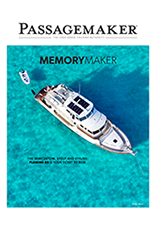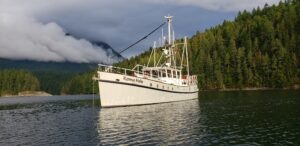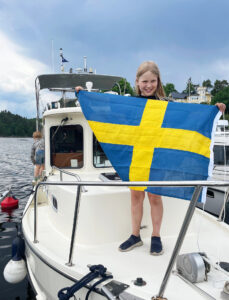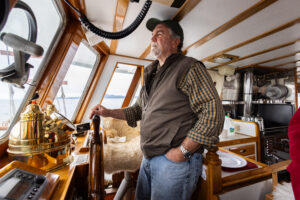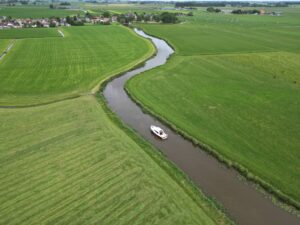
Follow along with Bob and Elaine Ebaugh aboard their 1985 DeFever 44, Mar Azul, as they spend two years cruising the waters off of South America from April 2011 through June 2013. To learn more about Bob and Elaine, as well as their home afloat click here.
July 23, 2011:
N 18° 17.8′ W 65° 15.3′
Bahía de Almodóvar, Culebra
We left Palmas on Tuesday for the two hour trip to Isla de Vieques, one of the Spanish Virgin Islands east of the Puerto Rican mainland. The history of Vieques is intriguing, especially its use by the US Navy for bombing practice. After much controversy and public protest, in 2003 the Navy closed Roosevelt Roads Naval Station on the eastern side of Puerto Rico and discontinued using Vieques. The land on the eastern and western portions of the island is now part of the Caribbean Wildlife Refuge. The park is proud of its diverse habitats representing coastal beaches, mangrove wetlands, and sub-tropical forests. There are two towns on the 21 x 4 mile island: Isabel Segunda on the north side and Esperanza on the south side. Developing tourism has been a goal since the naval base closure. With the large park lands, numerous gorgeous beaches, fishing, water sports, biophosphorescent bays, along with numerous little hotels, guest houses and restaurants, Vieques would be a wonderful vacation destination for one seeking to get away from civilization and enjoy the peaceful surroundings. Ideally we would have rented a car to cover the entire island, but did not find a suitable calm anchorage in close proximity to town to leave the boat and dogs. There are no public marina facilities on the island which might help boost nautical tourism.


We spent one night anchored off the southwest tip of the island at Punta Arenas (sunset at top), a beautiful location with a palm-lined beach, shallow azure seas and a scenic view of the El Yunque rainforest mountain on the mainland. The anchorage was a little rolly during our visit, and we moved on after one night to explore the south coast of the island. Puerto Real, the bay off the town of Esperanza, was even more rolly, so we skipped on to Sun Bay. With a southerly wind component, it, too was not comfortable, but we made note to return under different wind conditions since the huge beach there looked fabulous.

The next stop was Puerto Ferro, one of the bioluminescent bays on the island. It is a protected mangrove bay, and we had the place to ourselves at night. Mosquito Bay next door is touted as an “eighth wonder of the world” and kayak and electric boat operators offer tours on moonless nights to view the light show created by tiny organisms in the water. It was complicated to hook up with a tour group since we couldn’t get into Esperanza, so we did our own bio bay tour in Puerto Ferro via dinghy. It wasn’t spectacular, but you could see little lights when the water was disturbed and it made an interesting nighttime activity. The dogs, who love predictable routines, thought we were nuts to be out at bedtime steering the dinghy in circles, splashing the water. But they came along anyway preferring never to be left behind.
The weather forecast called for stronger winds and an approaching tropical wave over the weekend. We decided to move north to Isla de Culebra where there are more sheltered anchorages, and check out the north coast of Vieques another time. We also need to meet a Dell service tech in Culebra on Monday, since a part has arrived for our navigational laptop, which is having an LCD screen problem. We told them no rush, it could wait until we returned to Palmas on the mainland. However, once the warranty work was finally approved and outsourced to a service contractor, there is apparently an incentive to speedily complete the job. They were willing to send a tech out to wherever the boat might be as long as we could provide a street address! We gave the address of the Club Seabourne, a small resort hotel with a dinghy dock close to the Dakity anchorage. Hope the tech doesn’t mind the working conditions.

Thursday we made the 3 hour trip to Culebra and encountered 5 foot seas on a beam reach, a new point of sail for this cruise. The forces caused refrigerator #1 to open while under way, and some of the contents fell out. We were lucky that we didn’t have breakage. Lesson learned: always use the locks on the fridge while under way, even if you haven’t needed them for the last 1400 miles.
Bob strongly believes in back-up systems whenever feasible, and this is proving to be a wise philosophy. The new Northern Lights generator stopped working, and while we are awaiting a replacement part, the old Westerbeke generator is plugging away keeping our batteries charged and refrigeration and electrical appliances working. Then the electric head (toilet) in our cabin stopped flushing. Not good. We are using the head in the guest quarters while Bob investigates that problem. I stopped whining about my duties in the hot galley as chief cook, since today it beats being chief plumber.
July 24, 2011:
Enjoying a breezy, sunny day at Bahia de Almodóvar. The Puerto Rican Navy presence has grown since the last post.
It has been disturbing to follow the US deficit fiasco back home. The economies in all the destinations we have visited thus far (Bahamas, Turks & Caicos, Dominican Republic, Puerto Rico) have been adversely impacted with the ripple effect of world-wide economic woes. Here in Puerto Rico editorials are advising the public to prepare for the expected cuts in US assistance programs. Hopefully US leadership will be able to develop and agree on a long term strategic plan to stabilize and boost the country’s economy.
Mar Azul operates on a careful budget that is monitored and considered daily. With this trip’s timeframe being moved up significantly in our lives and fuel prices higher than initial estimates, it has been a challenge to come in at budget. Initially, compensating for higher fuel prices seemed insurmountable, but we have found ways to adjust.

So far we haven’t regretted our decision to purchase a power vessel. As former sailors, we considered the various cruising boat options knowing that a sailboat would give us more cruising range at potentially less cost. Reality is, we couldn’t really see ourselves doing a major ocean crossing in the future. I get seasick, and we like time at anchor and enjoying destinations. The trawler offered greater living and storage space, the convenience of many electrical appliances, and less physical requirements for operation. The trawler is a slow moving powerboat that maxes out at hull speed, like a sailboat. Our boat has stabilizers, an absolute must for me, given the boat’s full keel and tendency otherwise to roll. From a fuel perspective it operates much more economically than a faster planing power vessel. Our boat requires about 4 gallons per hour using both engines. Filled to capacity, the fuel range is about 1300 miles, more than adequate for our cruising desires. When considering that sails and rigging need maintenance and have a limited lifespan, we could justify the fuel costs of a trawler.
Since our departure, fuel prices have obviously increased, and fuel has been the greatest single cost these past four months. This will be reduced over the next eight months since we will cover significantly fewer miles per day. Insurance costs are next highest in the budget, with health insurance most substantial – no surprises there. We have met other cruisers who don’t carry health or boat insurance, and while that seems unacceptable to us at the moment, self-insurance has worked well for many people. Boat related costs & maintenance are coming in third, with the single biggest line item thus far being the extra supplies we purchased for the marina hurricane tie system.
Food costs are coming in lower than budget, and not because we have become great fishermen. It is more convenient and less expensive to dine aboard, which is a huge change from our past lifestyle. For the cost of a couple of nice meals out, I can provision for several weeks. In many of the more remote locations there is no dining out option, period. In some places transportation, weather and sea conditions are obstacles, with long dinghy rides, walks, rental car or taxi rides required to get to a restaurant. We do try to get out some to experience the local cuisine, and take advantage of opportunities to socialize. Some of the cruiser pot lucks and informal happy hour gatherings have been among the most memorable experiences of our trip.

Where we spend our nights is another budget consideration. Anchoring out is the least expensive option and requires about 3 gallons of fuel per day, or about $12 – 15 right now, to run the generator for three to four hours. That keeps the batteries charged and allows for use of the electric stove. Moorings are next lowest in cost, and available in some places. Moorings are basically anchor systems that are already set up for use. You simply pick up the mooring line and tie it to your boat and you are secured for the night. Moorings may be available in areas where anchors could damage coral harbors or would otherwise be difficult to set. They are also handy in tight locations where anchoring maneuvers might be a challenge (Warderick Wells in the Exumas is an example). In some locations moorings are free, such as in the Puerto Rican parks. In other locations, you pay a fee per night, usually $25-30 or so, that is paid ashore at a hotel or bar, or to an employee who comes by in a dinghy to collect the money. In some locations, such as Boot Key Harbor in Marathon, the mooring fee includes access to a dinghy dock, garbage disposal, and sewage pump out services. We have a solid anchor system, and feel more confident in the security of our own equipment, so we evaluate whether the mooring situation presented offers any benefit. To the daily mooring cost, we also have to add the cost of running the generator.
Tying up to a dock is most costly when paid on a daily rate. Marinas usually have daily, weekly, monthly, seasonal and annual rate plans, with significant discounts for longer contracts. We have found cheaper marina rates en route than at home, in the $1 – $1.50 per foot per night range, versus $2 – $4 per foot per night in Florida. So a 44 foot boat at $1 per foot would cost cost $44/night in a marina on the daily rate. In the marina, we don’t run the generator, we simply plug into the power system at the dock. Sometimes the marina fees include electricity and water, and sometimes utilities are metered and charged separately. Utility costs can be significant, and might add another $15 to $35 per night, depending on the fee schedule. En route, we plan our marina time carefully. It is a luxury and we need to have a good reason for choosing the marina versus a less costly option. Sometimes “we are tired of anchoring out and want to stay in a marina and run the air conditioning all day ” is adequate justification.
Since we have a seasonal contract at Palmas del Mar as part of our hurricane plan, and all utilities are included at a flat rate, right now it would be most economical to stay in the marina for the duration of the contract. However, we aren’t out cruising with the goal of sitting in a marina for long periods and figure that with weather threats this hurricane season we will have more than adequate marina time. When the weather is good, we want to spend time in the Spanish, US and British Virgin Islands.

One of the expenses we hadn’t considered prior to departure was international credit card fees. They have been small but annoying, and add another 2 – 3% to credit card purchases and ATM withdrawals. They aren’t a problem here in Puerto Rico, but we will encounter these fees again when we leave the area this winter and continue south. Our bank didn’t offer any solutions, so we found two other banking options with no international fees and are working to rearrange accounts. Setting up new accounts has been a hassle, and with hindsight, we could have more easily done this before we left home. Our recent address change seems to be a red flag. While it looks like a regular street address, the address shows up in the computer system as a mail forwarding service, not a physical residence.
With the address issue, the Patriot Act apparently mandates identify theft controls that have come into play. Both Bob & I have taken quizzes via phone on multiple occasions to validate our identity. One woman was frank in spelling out the rules, and said that the multiple choice quiz was timed, and if I failed to answer any question accurately or took too long, I would be declined and would have to go to a physical bank location (back in the States) with two forms of identification before they could open the account. Fortunately the questions, which are based on public records, have not been terribly hard, but there have been some that reached 25+ years into the past. Questions have included vehicles types and colors registered at various addresses, cities of residence, professional licenses held, personal statistics on drivers licenses, and former street addresses. If one had numerous vehicles in the family, moved frequently, or had a poorer than average memory, passing the quiz could be problematic.
Little daily expenses add up too, and are worth monitoring. When we left, Bob had a mean diet Coke habit, and could easily go through a six-pack a day as his primary beverage for hydration. At US prices, that was bad enough, but when we got to the Bahamas we were looking at about $1 per can prices. That annualizes at $2190 which is no small change in the budget. Then, we had to haul the cases of soda from the market to the boat via dinghy, find precious storage space on the boat,and then store all the used cans until we could off-load garbage. I challenged Bob to come up with an alternative. He reluctantly weaned off the sodas in favor of sun brewed iced tea using homemade water from Mar Azul’s watermaker. Although he still has an occasional soda I haven’t restocked since the Bahamas, and he actually prefers the tea.
All in all, we have a target budget, evaluate before we spend, monitor trends closely, and make every effort to keep on track. We feel we are enjoying a high quality of life even while forgoing many of the luxuries of our past lifestyle. It’s not a terribly painful process and it’s something that businesses and families do routinely to keep on track financially and avoid a deficit situation. So I’m wondering why it’s so hard for our country to do likewise.

